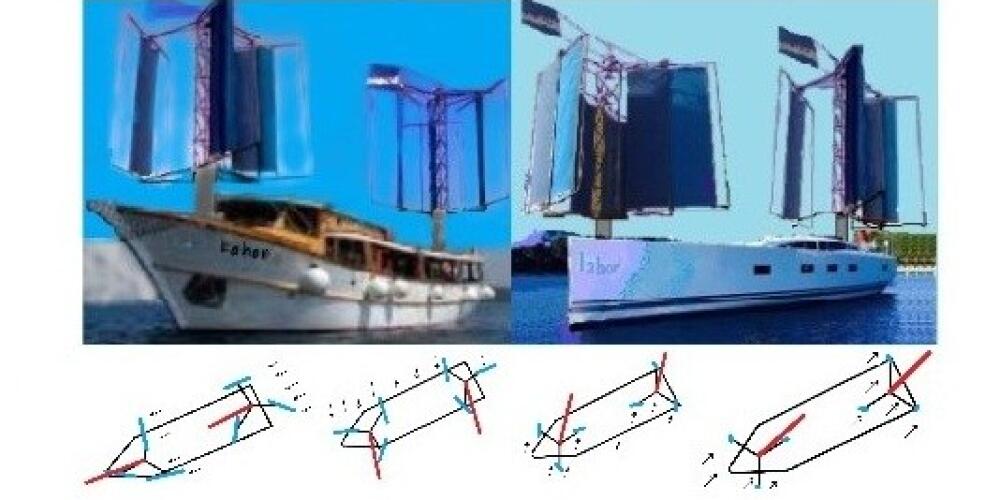
Ships have been using wind power for hundreds of years.
After the invention of the steam engine, and later the internal combustion engine, wind power was used only for sport and family sailboats. Development of a new type of windmill with rotating sails created the opportunity for ships to use wind power again.
This type of windmill is most similar to the Savonius rotor. However, it is three times more efficient in wind energy utilization.
The Savonius rotor has wind utilisation efficiency between 10 and 20 per cent, depending on wind speed. The positive force in the Savonius rotor is a result of the shape of the rotor that decreases drag on one side, and increases drag on the other side. Thus, the positive force diagram can be seen in the book Windmill with rotating sails to drag difference between the two forces.
Windmill with rotating sails
Windmill with rotating sails has the same efficiency as the biggest and the best horizontal axis windmills with three blades. Sails utilise wind energy through 300 degrees of the circle, while through only 60 degrees hinder rotation with a very little force.
This windmill has the ability to reduce the surface of the sail by 95% at strong winds, or in a situation when the ship is sailing directly into the wind. That is why it is a lot more efficient when compared to the other windmills.
One such windmill placed on the bow of a ship and the other on the stern section can operate while a ship is sailing or when it is anchored. In a case when ship is anchored, windmills can charge the accumulator.
The cheapest energy accumulator is compressed air.
The energy density of the compressed air when it comes to volume, is six-time less dense than oil.
However, that is not a problem for a ship, considering that a long high-pressure pipe that is placed on the bottom of a ship, can be used as a reservoir but also as a keel.
Windmills trigger compressors which squeeze air into a reservoir. Furthermore, air from a reservoir starts an air turbine that powers an electric generator. In this way, as long as there is wind or compressed air in a reservoir, everything on a ship is powered by electrical energy.
The windmill with rotating sails requires wind speed of at least 2 m/s to start working. Also, it works normally even at the strongest winds due to sails that have the ability to decrease its surface by 95%.
Thereby, it is possible to achieve a much higher number of working hours compared to classic windmills.
Compared to other vertical rotors such as Savonius and Darrieus rotor that use wind energy due to the shape of its resistant surface, windmill with rotating sails has a mechanism that adjusts sails into an optimum position, hence increases the efficiency of wind power utilisation.
Windmill with rotating sails works even during the storms, and it is not necessary to twists the sails so they no longer catch the wind and rotate, as it is the case when it comes to other types of windmills.
While most windmills use the lift to start working, and as a result spin six times faster than wind, a windmill with rotating sails uses the push. Due to using push instead of the lift, it rotates slower than wind.
This windmill was first patented in 1882 but the competitive oil industry was already strong enough to prevent its development. It was completely forgotten and even excluded from scientific literature.
The windmill with rotating sails was re-invented by the author of this article at the end of 1977. At the innovation exhibition Rast Yu in Rijeka in 1983, the author presented his metal model of the windmill. The dimensions of sails were 50x30 cm.
A slightly more developed model of 2x1m dimensions was shown at the exhibitions of Inova in 1985 and 1986 in Zagreb. Moreover, at the Iena exhibition in Nuremberg in 2000, the author received a gold medal after showing a short video presenting his prototype.
Not many attention was given to this innovation, and the investors were not interested in funding the project.
However, at the exhibition, the author found out from a random passer-by that one model of the windmill was being examined at the Institute of Technology in Zurich. The Institute was conducting strategical researches for the NATO at the time.
In 2006, the author created a bigger model of the windmill with sails that had the ability to contract and uploaded the video on YouTube. The first copies of that model appeared six months after the video was published and during the next 10 years, more than dozen manufacturers made their prototypes, which were industrially more developed. However, due to different interests, all these manufacturers have disappeared from the market as soon as they started their sales campaigns.
All in all, such type of windmills massively placed on the house roofs could significantly reduce the consumption of oil and coal. Considering it would not benefit these industries, many certain steps were taken in order to suffocate potential competition. Also, domestic windmills do not suit companies for electricity distribution, as the network traffic would be considerably reduced. Even countries have no gain from house windmills because it would be difficult to regulate energy taxes from someone who produces energy for themselves.
Many information and fake scientific tests played a role in creating disinformation among the expert community about the efficiency and costs of such windmills. Despite such opposing interests, the actual correct information has spread and its development can no longer be stopped. This will lead to its massive use,not only on house roofs but also on ships as well.
Other of my technical analyzes and innovations can be found in this book.
Tags
Featured articles